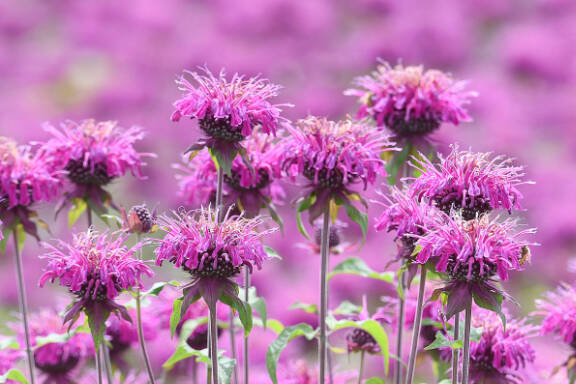Monarda, commonly known as bee balm, has been a popular garden perennial for many years.
Most of the modern hybrids come from two species native to the eastern United States. Today’s cultivars come in a range of colors, including white, red, purple and many shades in between. Sizes also vary greatly from dwarf selections just 12 inches tall to cultivars over 4 feet.
However, there is one significant problem with bee balm, and that is its tendency to develop powdery mildew. That’s always been reason enough for me not to grow them in my garden. This is not the case anymore!
Bee balms have many good qualities beyond their colorful flowers, which attract a whole host of pollinators, including hummingbirds, butterflies and all sorts of insects. They also can be used to make herbal tea and to sooth bee stings, hence the name.
They hail from the mint family, and any gardener worth their salt will immediately recognize that bee balm is a spreader. Just like mint, bee balm can take over an area in the garden if not tended to every few years.
Their roots – the spreading parts are what we call rhizomes – are all near the surface, so they are very easy to remove, either in spring when they start growing or even in fall before they go dormant. Dividing a clump every few years will keep it in a vigorous and healthy state, while also resulting in many more flowers.
Getting back to the mildew issue: For many years, I have trialed various new Monarda introductions that claimed to be mildew resistant. But, ultimately, they have all ended up on the compost pile. Any time we have warm days and cool nights, dew will often form in our gardens and, when there is dew, there will almost always be some degree of mildew.
Whether it’s on roses or hydrangeas or Exbury Azaleas, the only way to prevent it is to plant resistant varieties or proactively apply some sort of either natural or synthetic fungicide weekly while the weather is conducive to the disease. Obviously, resistant varieties are the easiest way to go, and that is where ‘Bee-You’ bee balm comes into the picture.
The breeding company of AB-Cultivars out of the Netherlands has recently introduced the ‘Bee-You’ series of bee balms to the world market, and they are available in garden centers this time of year.
The first thing you will notice is that the plants are short and stocky with lots of dark green leaves. They only grow 15 to 18 inches tall in the garden and will form a tidy clump 12 to 15 inches wide. There are seven to eight selected color variations, of which we are stocking the following three at the nursery:
Bee-You Bee Merry: Deep magenta buds open to show-stopping, rosy coral-pink blooms.
Bee-You Bee Happy: Showy cerise-red blooms on stiff, upright stems.
Bee-You Bee Free: Deep maroon buds that open to show-stopping, electric violet-purple blooms.
All bee balms prefer to grow in full sun with consistently moist soil. According to Monrovia Nursery, they make great companions to Daylily (Hemerocallis), Phlox, Turtlehead (Chelone), Catmint (Nepeta) and Iris.
The flowers are good for cutting and the plants will naturalize easily, as well as being quite happy in a planted container. And don’t forget the foliage can be used for making herbal teas.
In other words, this is a perennial that has many useful qualities and deserves a spot in our landscapes. This is the month to plunge a few of these new beauties into the garden!
Steve Smith represents Sunnyside Nursery in Marysville and can be reached at sunnysidenursery@msn.com
Talk to us
> Give us your news tips.
> Send us a letter to the editor.
> More Herald contact information.

























